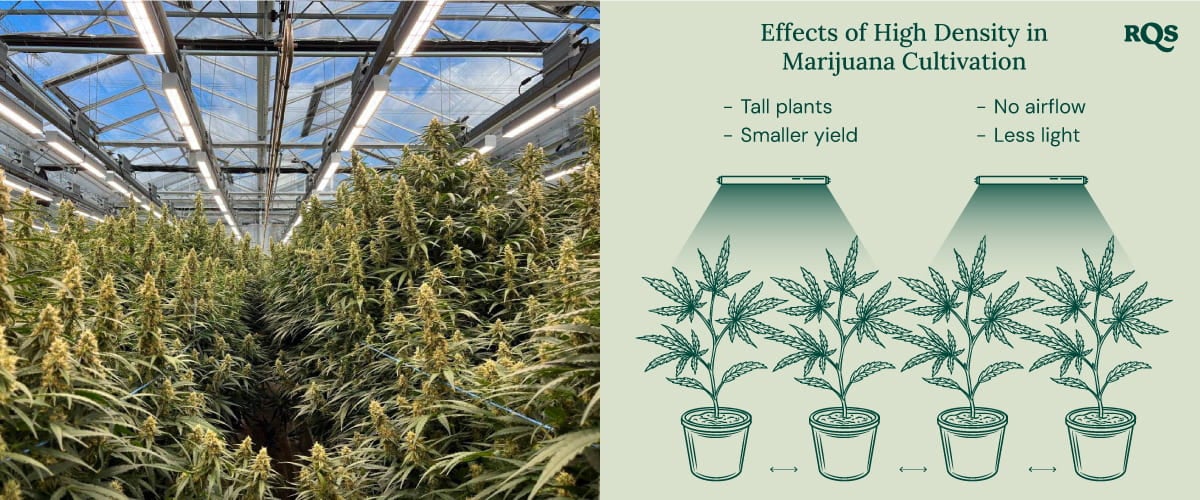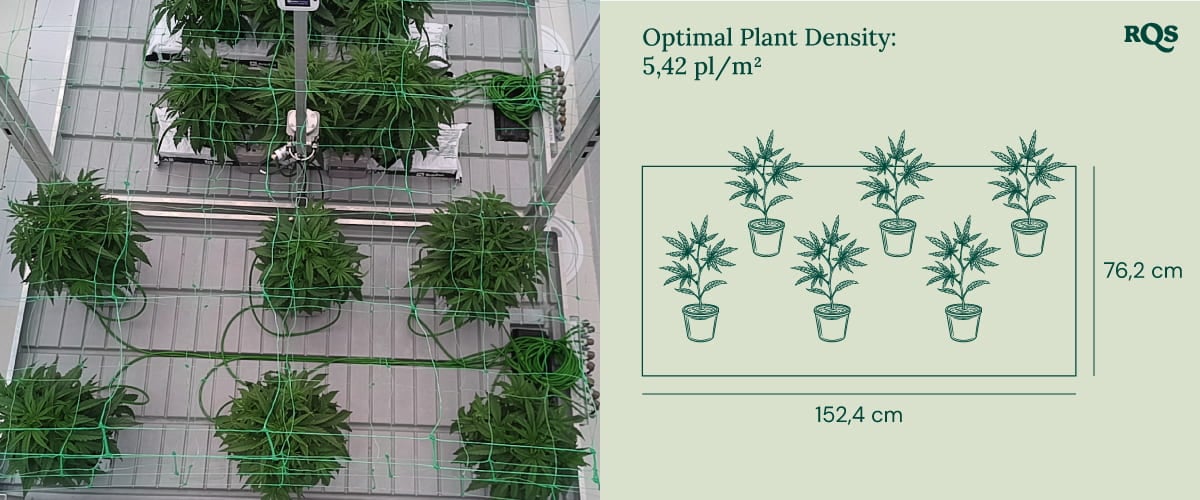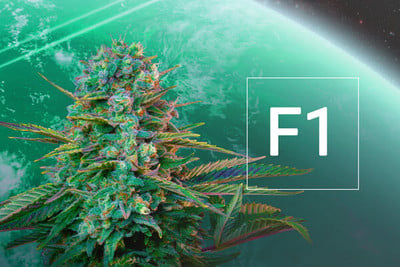.

Orion F1 Case Studies: Cannabis Plant Spacing
Have you ever wondered if your indoor grow space can handle one more plant without risking quality and yield? Through our trials with Orion F1, we discovered valuable insights. Learn how to achieve the ideal plant density for healthy growth and ensure maximum performance and yield.
Contents:
As growers, how many times have we asked ourselves if we can fit one more plant in our indoor garden, only to second guess ourselves moments later, wondering if we might be overdoing it? What if plants grow to infinity and beyond, as our friend Buzz Lightyear said? Well, in this article, we are going to clear up your doubts as we help you understand how the density of your plants per square metre affects their morphology—specifically their height. We'll use data from our two-year trials on the RQS F1 hybrid Orion F1 to illustrate the optimal plant density for healthy growth and top yields. Moreover, we will explain how the photoperiod and light intensity affect the height of your plants in relation to yield. Let's go!
What Is Plant Density in Cultivation?
Plant density represents the number of individual plants per unit of area. As the international unit of area is the square metre, this is what we will use in our discussion.
It is a very important parameter because, as we will see, plant density conditions the competitiveness of plants to obtain light, nutrients, carbon dioxide, water, and even airflow, which is necessary to facilitate transpiration (when plants release water through their pores).
With this in mind, the great gurus of indoor weed growing generally recommend a plant density that maximises the available growing space while also allowing sufficient distance for plants to receive inputs and transpire. This is done with a clear goal to not only ensure optimal plant health, but to maximise the yield potential of the plants per square metre.


Effects of High Density in Marijuana Cultivation
The most notable effect of high plant density indoors is elongation of the stems. In other words, the plants will be taller than if they were grown in a low-density setup.
Another interesting and well-known effect of high plant density concerns the number of roots per plant and the impact on the leaf area index (LAI)—although this is a topic for another article.
It is important to state that in all the studies carried out on the F1 hybrid varieties from Royal Queen Seeds, an increase in plant height is clearly observed at higher plant densities compared to lower plant densities.
In order to understand this phenomenon, however, it’s necessary to become acquainted with the relationship between photosynthetic photon flux density (PPFD), daily light integral (DLI), and yield.
-
Impact on the Height of Cannabis Plants
The simplified explanation of why cannabis plants grown in a high density per square metre are taller than those grown in a lower density is that the plants, not receiving all the available light, have to compete, surging upwards in hopes of capturing more illumination.
In more scientific terms, if we keep the PPFD and DLI constant while increasing the plant density, each plant receives fewer photons per unit of surface and per unit of time. As a result, the plant devotes its energy to biomass production, elongating its stems, stimulating the concentration of auxin in the areas close to the apical (cauline) meristems. In doing so, more parenchymatous and vascular cells can ultimately capture more photons, allowing plants to increase photosynthesis and create more biomass as a result.
In plants with apical dominance, such as Cannabis sativa, when the concentration of auxin in the apical meristems is high, an inhibitory effect is exerted on the tissues of the intercalary meristems to grow laterally. If we trim apically (topping/FIM), we favor the concentration of auxin to be lower in this area, thus causing growth of the intercalary meristems and ultimately an increase in the width of the plant.
So now you understand that the less light available, the fewer the photons, the greater the concentration of auxin in the apical meristems, and therefore the greater the height of the plant.


Comparative Analysis: F1 Orion Hybrid
If we compare the growth patterns of seven cultivation operations during a two-year study period on the Royal Queen Seeds hybrid variety Orion F1, we observe the following results in plants grown at an optimal density versus plants grown in a high plant density regime, depending on the DLI applied:
- Increase in height growth of up to 71% when the planting density is raised from 5.4 plants/m² to 7.9 plants/m²
- It is possible to mitigate or dampen the height growth caused by the increase in plant density if we increase the DLI from 39 moles/m²/day to 65 moles/m²/day.
- When we increase the DLI, we increase the photosynthetic photon flux density multiplied by the number of hours of the photoperiod in one day. As a result, the amount of auxin available in apical meristems is decreased and the plant not only grows less, but also has a higher yield in the form of more flowers per plant.
- Increase in plant density does not produce an increase in yield.
- Increase in DLI produces shorter plants.
- Increase in DLI produces plants with higher yields.
- Higher yields occur when plant density is optimal and DLI is high.
All of this data is worthwhile, and helps us to continue to understand how to optimise cannabis plant growth and health.
Practical Implications for Growers
Note that in order to obtain higher yields in cannabis cultivation and more grams of flowers per plant, we need optimal plant density and a high PPFD per number of hours of the photoperiod per day.
Therefore, if we opt for high plant densities, the height of the plants will also be high, unless we increase the light power (the PPFD and the hours of the photoperiod per day), in which case we can keep the height of the plants lower.
Furthermore, we can reduce the height growth of marijuana plants if we perform apical trimming (topping/FIM) to reduce apical dominance.
-
Optimal Cultivation Conditions
In accordance with our research on RQS F1 hybrids, the optimal conditions for indoor cannabis growth occurred when plant density per square metre was optimal and light exposure was powerful, with a photoperiod of 18 hours.
Specifically, significant yield increases were reported when we applied optimal crop densities of 5.4 plants/m² at a DLI of 65 moles/m²/day (1000 micromoles/m²/s at 18 hours of light per day.)
That being said, by using near-perfect parameters (hard to replicate in indoor home cultivation), including giving the plant supplementary CO₂, a huge amount of light per day, adjusting the correct light distance from the canopy, optimising plants per square metre, and delivering a high quantity of nutrients, our Orion F1 hybrid autoflower variety delivered a massive 1.4 kg per square metre!


Plant Density: It Makes a Huge Difference
As you can most likely see by now, it is important to strike a good balance between the density of cannabis plants per square metre and the daily light integral. For our case study, by applying optimal plant density conditions, we obtained more compact plants and higher yields.
Therefore, it is not by placing many plants very close together that we achieve higher yields—on the contrary. This simply results in taller, more spindly specimens with reduced flower weight per plant.
Now you know that there is an important relationship between plant density, light output, height, and yield. Using our own research, we hope to have conveyed this fascinating information to you, so that you can use it to your advantage!
Never Stop Experimenting
We encourage all growers to experiment with marijuana plant spacing and various light intensities. After all, what works for one grower doesn’t necessarily work for the other. Ultimately, there are few things more satisfying for a cannabis grower, whether expert or first-time, than improving and progressing in your practice.
And as we’ve alluded to several times in this article, perhaps the most influential factor dictating plant height and yield is the spectrum, composition, and availability of light. The spectrum of light is like its DNA, telling us how the photons are distributed in the various wavelengths that compose it. Two lights with the same power can have very different spectra, which can in turn greatly influence the growth and development of our weed plants.







































